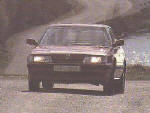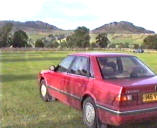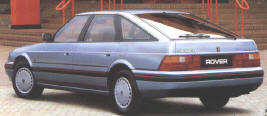Rover 800 story
Rover 825SD 800 Coupe 825i SD1 and Land Rover Web Site
![]()
|
|
A short account of the Rover 800 car and how it came about.
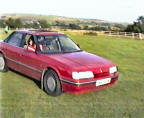
|
Click here for Repairs and Servicing page, contributed articles and
information
Descriptive and other
information
800 series FAQs
|
I bought my first 800
series, a 1986
Rover 825i V6 Auto when it was nearly three years old. The car had covered about 30,000 miles. The car was just
below the Sterling in terms of equipment. With electric windows,
sunroof, mirrors, trip computer, adjustable rear seats, alloy wheels.
Although my car was not fitted, some other similar models I have seen
also had ABS. This is how the 800 series cars came about |
|
Because of the situation at BL in the 1980s plans were made for a model to replace the SD1 which had by this time gained a reputation for poor build quality and reliability and other problems (see the SD1 section). Basically this would be a complete re-skin of the car to produce a "new" model as a replacement. This probably shows some of the thinking that went into producing models like the Marina that was fundamentally mechanical components from the parts bin in a new "tin" box approach. But in the early 1980s it was apparent that car design was developing at a rapid rate. Advances in the electronic control of engines and more sophisticated mechanical design was seen in competitors vehicles such as those from BMW, Vauxhall , Ford and others. This was necessary not only from the consumers expectation point of view but also to meet the more stringent emission and safety regulations that were coming into force globally. Tinkering with what bits and pieces existed would simply not do anymore. Austin Rover (as the company was now called) needed a brand new fresh platform if they hoped to be competitive. A path opened up from the cooperation with Honda which produced the Triumph Acclaim, which was really a re-badged Honda Ballard. Honda were keen to produce lager cars for the USA, as the largest model range they had at that time for the export market was about 1600 cc. On the one hand we had Austin Rover unable or unwilling to fund the massive cost of technical development needed to produce a new executive model, on the other Honda with more advanced engineering and technology but no experience in making large cars. Collaboration between the two would mean that both would gain from each other, and importantly for Rover the cost would be shared. Visually Rover's designers seemed to have carried over elements of the SD1's appearance into the new car that would come to be known as the 800, initially designated XX. The SD1 whatever peoples views about other aspects of it, was one of the most well proportioned designs, even after ten years in production it still looked modern. Compromises had to be made with Honda many of which were to do with the suspension of the car. Rover wanted to use a more traditional design which would occupy less room which could be given to the interior of the car. Honda wanted the double wishbone arrangement which was more complex and took up more space, also it had much less wheel movement. Perhaps the road surface in Japan is much smoother than those encountered in the UK and Europe, anyway only a limited amount of wheel travel was available. However this came about, it lead to one of the major criticisms of the 800, it's inability to soak up minor road irregularities in the same way as it's competitors did. The admittedly more ancient system on the SD1 had large wheel travel and was much better in this respect. The design of the new body shell was also constrained somewhat by Japanese width regulations which had to be adhered to if Honda was to sell their version of the cars on its home market. |
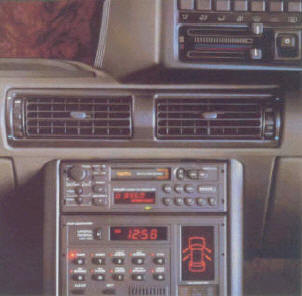
Where Rover were innovative. This is a 1987 car.
|
Despite all this a very good car was designed. Body structure and interior were areas where Honda got so much out of the project. The picture above is of the interior 1987 800 and shows how advanced Rover design could be at this time. Rover influence is still seen in Honda cars today. Honda had no interest in 4 cylinder engines for this car, so Rover produced a very fine development of the O series engine which became the powerful and durable M16 engine in fuel injected form producing 136PS. This was developed by borrowing from the knowledge gained from the Triumph Dolomite Sprint engine, history repeating itself, the 6 cylinder SD1 engines were developed from this Triumph engine design. As well as all the 820 models the M16 powered, it formed the basis in later years for the Mk2 2 litre turbo charged Vitesse with 200PS on tap. There was also a Land Rover that used the engine, the Discovery 2 Litre MPI. Although the Honda designed V6 2.5 litre engine was a powerful unit, it was not regarded as perfect for this type of vehicle by many critics. There was little torque produced at lower rpm. People were used to the type of response in executive cars that came from low engine speed of say the V8 in the SD1 for example, press the accelerator at any reasonable engine revolutions and you were on you way smoothly and without fuss. The V6 was powerful, but nothing much really happened until the revs rose above 4,000 rpm. Not what was expected from this type of "luxury" car. Much work was done to try to compensate for this but it was not until the arrival of the 177PS 2.7 litre version that the car really had an engine that suited its character. The 2.7 is a jewel of a power unit, see this advert from 1988. It is also a very reliable and long lasting engine. 250,000 miles + with no faults is not unknown with this V6. |
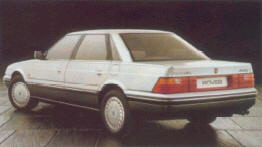
|
The first models released, the Rover Sterling and the Rover 825i were "booted" saloons, in many cases during the first year or so of production the actual trim level of the 825i was not noticeably much sort of the Sterling as dealer options were fitted on many. 820 versions went on sale some months later. To the range was added a hatch or fastback version which included the Vitesse referred to earlier. This had a look of the SD1 from some angles.
In 1990 the
825D turbo
diesel fastback was introduced. Fitted with
the very good Italian
VM Turbo 2.5 ltr. 4 cylinder 118 bhp engine
The basic model range was thus formed and with minor variations continued until the introduction of the new look Mk2 cars that most notably differ in appearance by having the chrome grill in the bonnet and rounder edges to the rear of the car. |
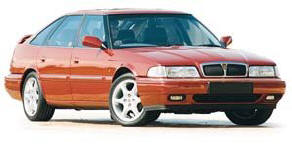
|
The 2 door Coupe version was also introduced with luxurious trim and various engine options from the 2 litre fuel injected, the V6 and the turbo charged 4 cylinder Vitesse version . |
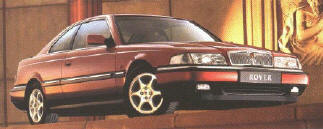
|
With the BMW takeover of Rover the end of the line for the 800 was in sight. The car was by this time quite an old design. The Honda V6 engine for whatever reason was replaced by the Rover designed KV6. It was 200 cc smaller than the unit it replaced even so produced 175PS with a good flattish torque curve. This engine went on to power the excellent Rover 75 (as well as being used in the Land Rover Freelander), and has proved to be reliable. It was not always that way. Stories are legion about KV6 failures when fitted in 800s, and dealers fitting new engines under warranty. The ownership of Rover passed from BMW's hands as the story of the 800 series draws to an end. What is interesting there is now no large Rover car. The 75 for all its (deserved) virtues is really a 600 series replacement. If you were to think this was the policy of the (then) owners BMW, to kill off some competition in this sector, you might well have that opinion, I could not comment! If you want a detailed record of the 800 a very comprehensive account of the 800 written by Keith Adams can be found here (and of other cars produced by BMC and its successors). Originally for the 825 diesel models only the link below is now expanding to cover the petrol version of the cars, much of the information applies equally to the various versions but always check the relevant workshop manuals before undertaking any of the procedures. Click here for Repairs and Servicing page, contributed articles and information
If you are interested in the Rover 800 series car consider joining the Rover 800 and Sterling mailing list. Here you will find expert advice on any problems you may encounter with the car and a friendly welcome from the 800 + members. Click on the button below. |

